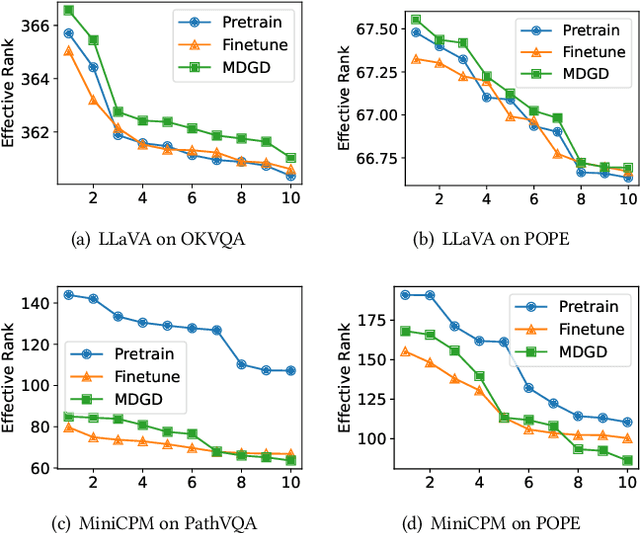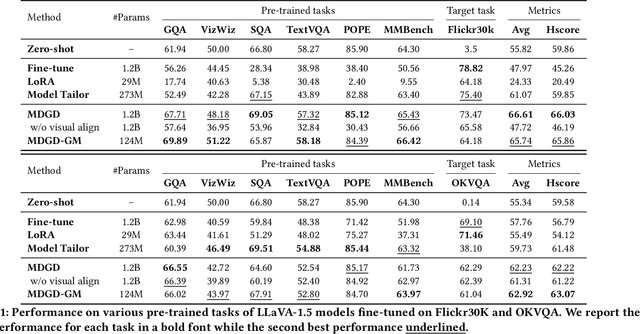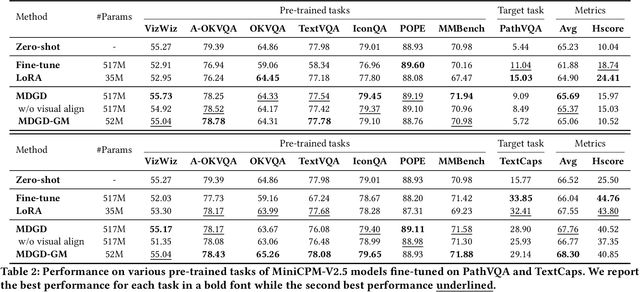Ruoyu Wang
Efficient and Generalizable Environmental Understanding for Visual Navigation
Jun 18, 2025



Abstract:Visual Navigation is a core task in Embodied AI, enabling agents to navigate complex environments toward given objectives. Across diverse settings within Navigation tasks, many necessitate the modelling of sequential data accumulated from preceding time steps. While existing methods perform well, they typically process all historical observations simultaneously, overlooking the internal association structure within the data, which may limit the potential for further improvements in task performance. We address this by examining the unique characteristics of Navigation tasks through the lens of causality, introducing a causal framework to highlight the limitations of conventional sequential methods. Leveraging this insight, we propose Causality-Aware Navigation (CAN), which incorporates a Causal Understanding Module to enhance the agent's environmental understanding capability. Empirical evaluations show that our approach consistently outperforms baselines across various tasks and simulation environments. Extensive ablations studies attribute these gains to the Causal Understanding Module, which generalizes effectively in both Reinforcement and Supervised Learning settings without computational overhead.
Exploring Speaker Diarization with Mixture of Experts
Jun 17, 2025Abstract:In this paper, we propose a novel neural speaker diarization system using memory-aware multi-speaker embedding with sequence-to-sequence architecture (NSD-MS2S), which integrates a memory-aware multi-speaker embedding module with a sequence-to-sequence architecture. The system leverages a memory module to enhance speaker embeddings and employs a Seq2Seq framework to efficiently map acoustic features to speaker labels. Additionally, we explore the application of mixture of experts in speaker diarization, and introduce a Shared and Soft Mixture of Experts (SS-MoE) module to further mitigate model bias and enhance performance. Incorporating SS-MoE leads to the extended model NSD-MS2S-SSMoE. Experiments on multiple complex acoustic datasets, including CHiME-6, DiPCo, Mixer 6 and DIHARD-III evaluation sets, demonstrate meaningful improvements in robustness and generalization. The proposed methods achieve state-of-the-art results, showcasing their effectiveness in challenging real-world scenarios.
Recollection from Pensieve: Novel View Synthesis via Learning from Uncalibrated Videos
May 19, 2025Abstract:Currently almost all state-of-the-art novel view synthesis and reconstruction models rely on calibrated cameras or additional geometric priors for training. These prerequisites significantly limit their applicability to massive uncalibrated data. To alleviate this requirement and unlock the potential for self-supervised training on large-scale uncalibrated videos, we propose a novel two-stage strategy to train a view synthesis model from only raw video frames or multi-view images, without providing camera parameters or other priors. In the first stage, we learn to reconstruct the scene implicitly in a latent space without relying on any explicit 3D representation. Specifically, we predict per-frame latent camera and scene context features, and employ a view synthesis model as a proxy for explicit rendering. This pretraining stage substantially reduces the optimization complexity and encourages the network to learn the underlying 3D consistency in a self-supervised manner. The learned latent camera and implicit scene representation have a large gap compared with the real 3D world. To reduce this gap, we introduce the second stage training by explicitly predicting 3D Gaussian primitives. We additionally apply explicit Gaussian Splatting rendering loss and depth projection loss to align the learned latent representations with physically grounded 3D geometry. In this way, Stage 1 provides a strong initialization and Stage 2 enforces 3D consistency - the two stages are complementary and mutually beneficial. Extensive experiments demonstrate the effectiveness of our approach, achieving high-quality novel view synthesis and accurate camera pose estimation, compared to methods that employ supervision with calibration, pose, or depth information. The code is available at https://github.com/Dwawayu/Pensieve.
Optimizing Multi-Round Enhanced Training in Diffusion Models for Improved Preference Understanding
Apr 25, 2025Abstract:Generative AI has significantly changed industries by enabling text-driven image generation, yet challenges remain in achieving high-resolution outputs that align with fine-grained user preferences. Consequently, multi-round interactions are necessary to ensure the generated images meet expectations. Previous methods enhanced prompts via reward feedback but did not optimize over a multi-round dialogue dataset. In this work, we present a Visual Co-Adaptation (VCA) framework incorporating human-in-the-loop feedback, leveraging a well-trained reward model aligned with human preferences. Using a diverse multi-turn dialogue dataset, our framework applies multiple reward functions, such as diversity, consistency, and preference feedback, while fine-tuning the diffusion model through LoRA, thus optimizing image generation based on user input. We also construct multi-round dialogue datasets of prompts and image pairs aligned with user intent. Experiments demonstrate that our method outperforms state-of-the-art baselines, significantly improving image consistency and alignment with user intent. Our approach consistently surpasses competing models in user satisfaction, especially in multi-turn dialogue scenarios.
Efficient Temporal Consistency in Diffusion-Based Video Editing with Adaptor Modules: A Theoretical Framework
Apr 22, 2025Abstract:Adapter-based methods are commonly used to enhance model performance with minimal additional complexity, especially in video editing tasks that require frame-to-frame consistency. By inserting small, learnable modules into pretrained diffusion models, these adapters can maintain temporal coherence without extensive retraining. Approaches that incorporate prompt learning with both shared and frame-specific tokens are particularly effective in preserving continuity across frames at low training cost. In this work, we want to provide a general theoretical framework for adapters that maintain frame consistency in DDIM-based models under a temporal consistency loss. First, we prove that the temporal consistency objective is differentiable under bounded feature norms, and we establish a Lipschitz bound on its gradient. Second, we show that gradient descent on this objective decreases the loss monotonically and converges to a local minimum if the learning rate is within an appropriate range. Finally, we analyze the stability of modules in the DDIM inversion procedure, showing that the associated error remains controlled. These theoretical findings will reinforce the reliability of diffusion-based video editing methods that rely on adapter strategies and provide theoretical insights in video generation tasks.
L2COcc: Lightweight Camera-Centric Semantic Scene Completion via Distillation of LiDAR Model
Mar 16, 2025Abstract:Semantic Scene Completion (SSC) constitutes a pivotal element in autonomous driving perception systems, tasked with inferring the 3D semantic occupancy of a scene from sensory data. To improve accuracy, prior research has implemented various computationally demanding and memory-intensive 3D operations, imposing significant computational requirements on the platform during training and testing. This paper proposes L2COcc, a lightweight camera-centric SSC framework that also accommodates LiDAR inputs. With our proposed efficient voxel transformer (EVT) and cross-modal knowledge modules, including feature similarity distillation (FSD), TPV distillation (TPVD) and prediction alignment distillation (PAD), our method substantially reduce computational burden while maintaining high accuracy. The experimental evaluations demonstrate that our proposed method surpasses the current state-of-the-art vision-based SSC methods regarding accuracy on both the SemanticKITTI and SSCBench-KITTI-360 benchmarks, respectively. Additionally, our method is more lightweight, exhibiting a reduction in both memory consumption and inference time by over 23% compared to the current state-of-the-arts method. Code is available at our project page:https://studyingfufu.github.io/L2COcc/.
Mitigating Visual Knowledge Forgetting in MLLM Instruction-tuning via Modality-decoupled Gradient Descent
Feb 17, 2025



Abstract:Recent MLLMs have shown emerging visual understanding and reasoning abilities after being pre-trained on large-scale multimodal datasets. Unlike pre-training, where MLLMs receive rich visual-text alignment, instruction-tuning is often text-driven with weaker visual supervision, leading to the degradation of pre-trained visual understanding and causing visual forgetting. Existing approaches, such as direct fine-tuning and continual learning methods, fail to explicitly address this issue, often compressing visual representations and prioritizing task alignment over visual retention, which further worsens visual forgetting. To overcome this limitation, we introduce a novel perspective leveraging effective rank to quantify the degradation of visual representation richness, interpreting this degradation through the information bottleneck principle as excessive compression that leads to the degradation of crucial pre-trained visual knowledge. Building on this view, we propose a modality-decoupled gradient descent (MDGD) method that regulates gradient updates to maintain the effective rank of visual representations while mitigating the over-compression effects described by the information bottleneck. By explicitly disentangling the optimization of visual understanding from task-specific alignment, MDGD preserves pre-trained visual knowledge while enabling efficient task adaptation. To enable lightweight instruction-tuning, we further develop a memory-efficient fine-tuning approach using gradient masking, which selectively updates a subset of model parameters to enable parameter-efficient fine-tuning (PEFT), reducing computational overhead while preserving rich visual representations. Extensive experiments across various downstream tasks and backbone MLLMs demonstrate that MDGD effectively mitigates visual forgetting from pre-trained tasks while enabling strong adaptation to new tasks.
Latent Swap Joint Diffusion for Long-Form Audio Generation
Feb 07, 2025



Abstract:Previous work on long-form audio generation using global-view diffusion or iterative generation demands significant training or inference costs. While recent advancements in multi-view joint diffusion for panoramic generation provide an efficient option, they struggle with spectrum generation with severe overlap distortions and high cross-view consistency costs. We initially explore this phenomenon through the connectivity inheritance of latent maps and uncover that averaging operations excessively smooth the high-frequency components of the latent map. To address these issues, we propose Swap Forward (SaFa), a frame-level latent swap framework that synchronizes multiple diffusions to produce a globally coherent long audio with more spectrum details in a forward-only manner. At its core, the bidirectional Self-Loop Latent Swap is applied between adjacent views, leveraging stepwise diffusion trajectory to adaptively enhance high-frequency components without disrupting low-frequency components. Furthermore, to ensure cross-view consistency, the unidirectional Reference-Guided Latent Swap is applied between the reference and the non-overlap regions of each subview during the early stages, providing centralized trajectory guidance. Quantitative and qualitative experiments demonstrate that SaFa significantly outperforms existing joint diffusion methods and even training-based long audio generation models. Moreover, we find that it also adapts well to panoramic generation, achieving comparable state-of-the-art performance with greater efficiency and model generalizability. Project page is available at https://swapforward.github.io/.
The Silent Prompt: Initial Noise as Implicit Guidance for Goal-Driven Image Generation
Dec 06, 2024



Abstract:Text-to-image synthesis (T2I) has advanced remarkably with the emergence of large-scale diffusion models. In the conventional setup, the text prompt provides explicit, user-defined guidance, directing the generation process by denoising a randomly sampled Gaussian noise. In this work, we reveal that the often-overlooked noise itself encodes inherent generative tendencies, acting as a "silent prompt" that implicitly guides the output. This implicit guidance, embedded in the noise scheduler design of diffusion model formulations and their training stages, generalizes across a wide range of T2I models and backbones. Building on this insight, we introduce NoiseQuery, a novel strategy that selects optimal initial noise from a pre-built noise library to meet diverse user needs. Our approach not only enhances high-level semantic alignment with text prompts, but also allows for nuanced adjustments of low-level visual attributes, such as texture, sharpness, shape, and color, which are typically challenging to control through text alone. Extensive experiments across various models and target attributes demonstrate the strong performance and zero-shot transferability of our approach, requiring no additional optimization.
SOWing Information: Cultivating Contextual Coherence with MLLMs in Image Generation
Nov 28, 2024



Abstract:Originating from the diffusion phenomenon in physics, which describes the random movement and collisions of particles, diffusion generative models simulate a random walk in the data space along the denoising trajectory. This allows information to diffuse across regions, yielding harmonious outcomes. However, the chaotic and disordered nature of information diffusion in diffusion models often results in undesired interference between image regions, causing degraded detail preservation and contextual inconsistency. In this work, we address these challenges by reframing disordered diffusion as a powerful tool for text-vision-to-image generation (TV2I) tasks, achieving pixel-level condition fidelity while maintaining visual and semantic coherence throughout the image. We first introduce Cyclic One-Way Diffusion (COW), which provides an efficient unidirectional diffusion framework for precise information transfer while minimizing disruptive interference. Building on COW, we further propose Selective One-Way Diffusion (SOW), which utilizes Multimodal Large Language Models (MLLMs) to clarify the semantic and spatial relationships within the image. Based on these insights, SOW combines attention mechanisms to dynamically regulate the direction and intensity of diffusion according to contextual relationships. Extensive experiments demonstrate the untapped potential of controlled information diffusion, offering a path to more adaptive and versatile generative models in a learning-free manner.
 Add to Chrome
Add to Chrome Add to Firefox
Add to Firefox Add to Edge
Add to Edge